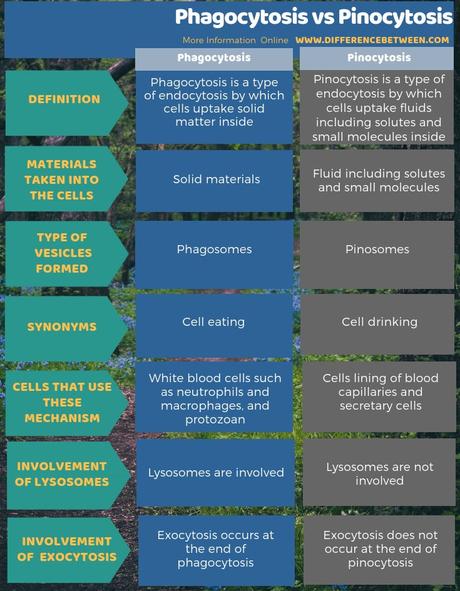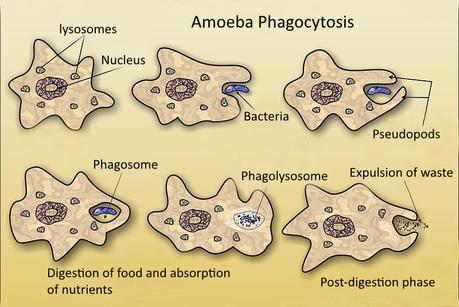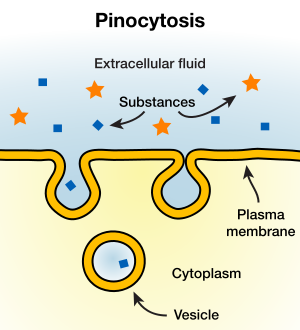In this article we discuss about the major difference between phagocytosis and pinocytosis is that a phagocytosis is a form of endocytosis that uptakes solids through the plasma membrane to the cell while pinocytosis is another form of endocytosis which uptakes fluids including solutes and small molecules through the plasma membrane to the cell.
Endocytosis is a mechanism by which cells intake macromolecules and other suspended particles including cell parts, macromolecular aggregates, and foreign particles into the cell. Exocytosis is the opposite mechanism of endocytosis by which cells exclude substances from the cells. Exocytosis takes place mainly in secretory cells. There are two types of endocytosis based on the nature of the particles that are taken into living cells. They are phagocytosis and pinocytosis. The mechanism used in both processes is the same. They form vesicles surrounding the materials in order to take them inside. Both processes are active processes. Hence, you can observe mitochondria near the surfaces where these processes occur.
What is the Difference Between Phagocytosis and Pinocytosis?
Main Differences – Phagocytosis vs Pinocytosis
Meaning Pinocytosis is called cell drinking, substance is directly ingested as it is in dissolved form and ready for cellular absorption. Phagocytosis is called cell eating, in which particles are broken down into simpler substance with the help of enzymes for absorption.
Process of engulfing By Invagination. By pseudopodia (false feet).
Kind of particles ingested Liquid. Solid.
Substrate specific Pinocytosis is not substrate specific and cell takes all kind of surrounding fluids with all solutes present. Phagocytosis is specific in substrate it transport.
Purpose Pinocytosis is used for intake of materials. Phagocytosis is used for defensive purpose by engulfing the foreign particles.
Vesicles formed Pinosomes. Phagosomes.
Role of Lysosomes No role of lysosomes. Lysosomes combine with phagosomes for the formation of food vacuole.
Types of particles intake Sugars, ions, amino acids, enzymes, hormones, etc. Foreign particles, harmful bacteria and virus, dust, etc.
Where it happens Pinocytosis usually occurs in secretory cells, cell linings of blood capillaries. Phagocytosis is performmed by neutrophills, macrophages and protozoans.

What is Phagocytosis
Cell eating is also called Phagocytosis. Phagocytosis is the ingestion of large solid particles by the cell during endocytosis. In multicellular organisms, particles like cell debris, aged cells, small mineral particles, dust, various colloids, and bacteria are phagocytized by the cells in the immune system, playing a vital role in the defense of the organism.
The cells in the immune system like tissue macrophages, neutrophils, and monocytes are called professional phagocytes. Phagocytosis can also be found in Langerhans cells in the skin, Kupffer cells in the liver, the pigmented epithelium of the eye, and microglia in the brain. Phagocytosis occurs through various receptors like immunoglobulin G, mannose (MR), β-glucan, and complement (CR1, CR3). Hence, it is considered as a triggered process.
The particles are surrounded by pseudopodia and then pinched off into vesicles. These vesicles are called phagosomes. Phagosomes are fused with lysosomes, forming the phagolysosomes. Lysosomes contain the enzymes necessary for the breaking down of particles.
The waste material formed during the digestion are expelled by exocytosis. Sometimes, the phagocytized particle can be as large as the cell. Therefore, cells need to form large vesicles during phagocytosis.
Phagocytosis is also known as cell eating in single-celled organisms. Most protists like amoeba also uptake nutrients by phagocytosis. Essential nutrients can be taken into the cell by phagocytosis. The uptaking of nutrients often does not produce waste material. Amoeba phagocytosis is shown in figure 1.

Figure 1: Amoeba Phagocytosis
What is Pinocytosis
Cell drinking is another name of Pinocytosis. Pinocytosis is the ingestion of fluids along with the solutes into the cell by invagination. Almost all cells in the body of multicellular organisms perform pinocytosis. Pinocytosis occurs through narrow channels in the membrane.
The plasma membrane surrounds the liquid in order to pinch them off into the cell. During pinocytosis, small uniform vesicles called pinosomes are formed. Pinosomes are formed by clathrin-coated pits in the plasma membrane. The total area of the clathrin-coated pits in a cell is about 2% of the total area of the plasma membrane.
The resultant vesicle is also clathrin-coated. Some of the pathways initiated at caveolae lack clathrin-coated vesicles. Pinocytosis is considered as a constitutive process, occurring continuously. The amount of the fluid which is being pinocytized varies on different cell types. Usually, macrophages uptake fluid equal to 25% of its volume per hour.
But, the surface area and the volume of the cell remain unchanged during pinocytosis. Some of the extracellular macromolecules like cholesterol are uptaken by receptor-mediated endocytosis, which increases the efficiency of the process by specifying the macromolecule to be uptaken. The process requires energy in the form of ATP. Pinocytosis is shown in figure 2.

Figure 2: Pinocytosis
What are the Similarities Between Phagocytosis and Pinocytosis?
- Phagocytosis and pinocytosis are two types of endocytosis.
- Both methods take in materials through the plasma membrane by forming vesicles
Difference Between Phagocytosis and Pinocytosis
Definition
Phagocytosis: The ingestion of solid particles into the cell by phagocyte is referred to as phagocytosis.
Pinocytosis: The ingestion of liquid droplets into the cell by small vesicles is referred to as pinocytosis.
Method of Protrusion
Phagocytosis: Pseudopodia are formed during phagocytosis. Vesicles are formed around the particle by evagination.
Pinocytosis: Invagination occurs during pinocytosis.
Diameter
Phagocytosis: During phagocytosis, around 1-2 µm size particles are ingested.
Pinocytosis: During pinocytosis, around 0.1-0.2 µm size liquid droplets are ingested.
Nature of the Process
Phagocytosis: Phagocytosis is a triggered process, involving receptors like IgG.
Pinocytosis: Pinocytosis is a constitutive process, occurring continuously.
Occurrence
Phagocytosis: Phagocytosis occurs in tissue macrophages, neutrophils and monocytes and some other cells like Langerhans cells in the skin and Kupffer cells in the liver.
Pinocytosis: Pinocytosis occurs in almost all the cells in the body of a multicellular organism.
Alternative Names
Phagocytosis: Phagocytosis is called cell eating.
Pinocytosis: Pinocytosis is called cell drinking.
Formed Vesicle Type
Phagocytosis: During phagocytosis, phagosomes are formed.
Pinocytosis: During pinocytosis, pinosomes are formed.
Vesicle Size
Phagocytosis: Vesicles formed during phagocytosis are comparatively large.
Pinocytosis: Vesicles formed during pinocytosis are small.
Break Down of Particles
Phagocytosis: Ingested particles by phagocytosis are broken down into simple substances before absorption.
Pinocytosis: Ingested liquids by pinocytosis are readily absorbed.
Exocytosis
Phagocytosis: At the end of the phagocytosis, exocytosis occurs in order to throw out the waste.
Pinocytosis: No exocytosis occurs after pinocytosis.
Involvement of Lysosomes
Phagocytosis: Food vacuoles are formed by the combination of phagosomes and lysosomes.
Pinocytosis: Lysosomes are not involved with pinosomes in the process.
Function
Phagocytosis: Phagocytosis is generally used for the defensive purposes of the cell.
Pinocytosis: Pinocytosis is used in order to intake important materials.
Location
Phagocytosis: Phagocytosis is mostly found in the immune cells of the body.
Pinocytosis: Pinocytosis usually occurs in almost all the cells in the body.
Examples
Phagocytosis: Engulfment of bacteria by white blood cells and engulfment of food particles by cells are examples for phagocytosis.
Pinocytosis: Uptaking of enzymes and hormones from the extracellular fluid is an example of pinocytosis.
Conclusion – Phagocytosis vs Pinocytosis
Phagocytosis and pinocytosis are two variations of the process of endocytosis, where the cell takes in material from the extracellular fluid. During phagocytosis, large solid particles are taken in, which are then digested by the enzymes contained in lysosomes.
Dead cells, as well as the bacteria like pathogens, can be digested by phagocytosis, eliminating the waste substances by exocytosis. Hence, phagocytosis is involved in the defense of the cell. During pinocytosis, small vesicles are formed by the ingestion of fluids from the extracellular environment.
Phagocytosis is involved in the digestion of the uptaken material with the aid of enzymes stored in lysosomes. But in pinocytosis, no digestion is possessed but ingested materials are readily absorbed. Therefore, the main difference between phagocytosis and pinocytosis is the quality of the material taken in by each of the processes.
Reference:
- Lennartz, Michelle R. “Phospholipases, and Phagocytosis.” Madame Curie Bioscience Database [Internet]. U.S. National Library of Medicine, 01 Jan. 1970. Web. 31 Mar. 2017.Cooper, Geoffrey
- M. “Lysosomes.” The Cell: A Molecular Approach. 2nd edition. U.S. National Library of Medicine, 01 Jan. 1970. Web. 31 Mar. 2017.
- Alberts, Bruce. “Transport into the Cell from the Plasma Membrane: Endocytosis.” Molecular Biology of the Cell. 4th edition. U.S. National Library of Medicine, 01 Jan. 1970. Web. 31 Mar. 2017.
- Cooper, Geoffrey M. “Endocytosis.” The Cell: A Molecular Approach. 2nd edition. U.S. National Library of Medicine, 01 Jan. 1970. Web. 31 Mar. 2017.
- “Pinocytosis.” Encyclopædia Britannica, Encyclopædia Britannica, Inc., 20 Nov. 2014, Available here.
- “Phagocytosis.” Khan Academy, Available here.
- Difference Between Phagocytosis and Pinocytosis Available here.Link2.Link3.
Image Courtesy:
- “Amoeba phagocytosis” By Miklos – Wikimedia commons (Public Domain) via Commons Wikimedia
- “Pinocytosis” By Jacek FH – modified Image: Endocytosis types.svg, author Mariana Ruiz Villarreal LadyofHats, (Public Domain) via Commons Wikimedia
- Difference Between Phagocytosis and Pinocytosis Link2.

